Discover the serene beauty of zen garden design with 23zen. Explore how simple outdoor spaces can foster tranquility. This approach blends natural elements with mindful arrangement. Create a peaceful retreat or a minimalist landscape. 23zen offers inspiration and practical tips for cultivating an inviting environment.
Understanding Zen Garden Philosophy

Zen gardens offer more than just visual appeal. They represent a profound philosophy focused on simplicity and peace. The picture showcases a calming stone arrangement on carefully raked sand. It perfectly demonstrates the key ideas behind this art form.
Every stone embodies a natural force, mirroring mountains or serene islands. Their smooth, rounded forms evoke a feeling of peace and equilibrium. Observe the carefully drawn lines in the sand; they depict gentle water currents, encouraging tranquility and mindful reflection.
Zen gardens foster present moment awareness. Contemplate the arrangement and consider life’s intricacies. The design’s simplicity promotes mental clarity, creating space for calm reflection. Building or tending a Zen garden offers a meditative experience.
This serene area encourages calm and thoughtful reflection. It serves as a prompt to decelerate and value nature’s elegance, even within a simple design. Grasping this concept allows anyone to welcome the tranquil spirit of a Zen garden into their daily routine.
Creating Balance with Rock Arrangements

Zen gardens use rock arrangements to create balance. Different rock sizes and shapes bring a sense of calm. Placing large stones with smaller ones makes focal points. These focal points attract attention and foster a serene environment.
Observe the varied textures and colors of the rocks in this image. This diversity enhances the landscape’s depth, creating visual interest without being overwhelming. Incorporating rocks with different shades can replicate the authentic beauty of pristine natural environments.
Strategic stone placement fosters mindfulness. While designing your garden, contemplate the spaces between rocks. These gaps can represent pathways, guiding your thoughts during meditation or relaxation.
Feel free to play around with rock positions. Often, the best-looking arrangements result from some experimentation. Pause regularly to assess your design from various viewpoints. This helps create a garden that feels harmonious and welcoming.
Selecting the Ideal Plants for Zen Gardens
Designing a Zen garden goes beyond mere visual appeal. It’s a journey towards inner peace and harmony. Your plant selection is key to crafting this serene atmosphere. The image showcases bamboo and vibrant foliage, illustrating how diverse plants enhance the garden’s tranquil essence. This reflects the garden’s overall peaceful ambiance.
Bamboo remains a favored option for its elegant height and beauty. It represents resilience and adaptability, mirroring Zen principles. Choose bamboo types suited to your local weather conditions, as cold tolerance differs significantly.
Beyond bamboo, explore low-maintenance soft plants. Moss and ornamental grasses, as pictured, introduce appealing textures and colors. These choices demand little upkeep. Their rounded forms and lively greens amplify the garden’s tranquil atmosphere.
In 2025, remember the importance of hardscaping. Stones and pebbles used in pathways visually guide and harmonize the garden. Combine these with your plants to clearly define spaces and create a sense of organized beauty.
Consider seasonal shifts for a vibrant garden year-round. Combine evergreens with plants that bloom in different seasons. This ensures continuous visual appeal and maintains a serene atmosphere throughout the year.
Incorporating Water Features into Zen Gardens

Zen garden designs often feature water elements to foster tranquility. This image highlights a stunning combination of rocks, plants, and flowing water. It’s a perfect example of serene design principles.
This round pond, brimming with polished stones and framed by artfully placed rocks, beckons you to unwind. The water feature provides captivating visuals and generates calming sounds, enriching the ambiance of the area.
Adding plants, such as the vibrant green centerpiece, brings life to your garden. Zen gardens emphasize balance and harmony. The blend of water, stones, and foliage creates a peaceful, nature-connected atmosphere.
Planning a water feature for your zen garden? Think about its harmony with the existing landscape. A miniature pond or gentle stream makes an ideal centerpiece. It encourages peaceful contemplation and serenity in your personal sanctuary.
Designing for Minimalism and Simplicity
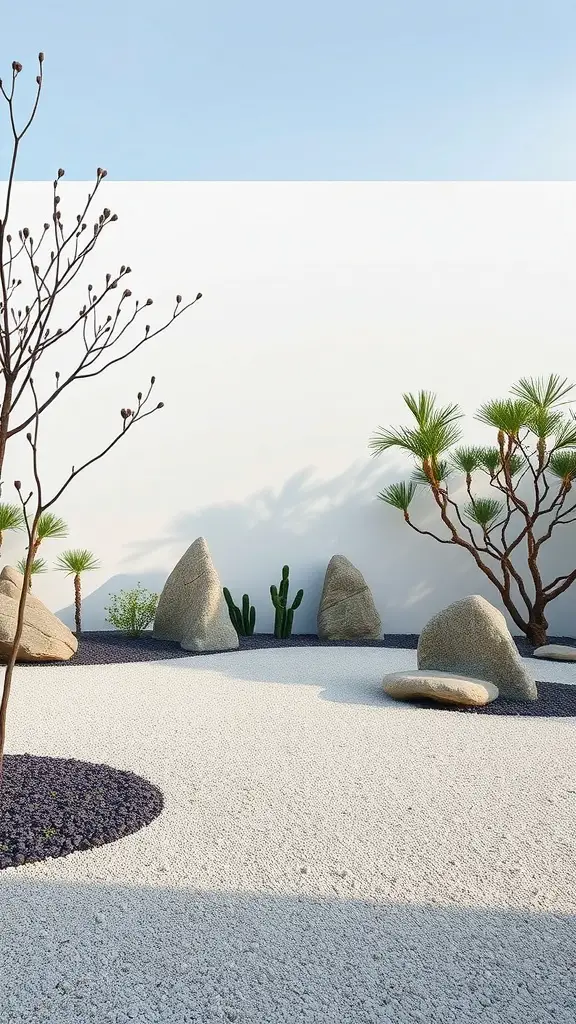
Crafting a zen garden? Embrace minimalism and simplicity. This image showcases a tranquil setting. Notice the deliberate arrangement of stones and plants. It fosters a peaceful and mindful environment. The design’s simplicity promotes a calming experience.
The bright white gravel offers a stunning contrast against the dark rocks and lush green plants. This color scheme is key to a zen garden’s design, fostering a sense of peace. Every part, from the stones to the trees, is carefully selected for its beauty and deeper meaning, ensuring each element contributes to the overall harmony.
Integrating natural components, such as sharp cacti and soft trees, introduces diversity without being overwhelming. The design is open and welcoming, encouraging exploration while preserving a sense of structure. This equilibrium is what makes Zen gardens so appealing—they foster contemplation and tranquility.
Crafting your personal zen sanctuary? Focus on simplicity and nature. Use clean lines and organic elements to cultivate balance. A carefully chosen centerpiece can transform the space. Embrace minimalism; less clutter equals more tranquility.
Choosing the Right Location for Your Zen Garden
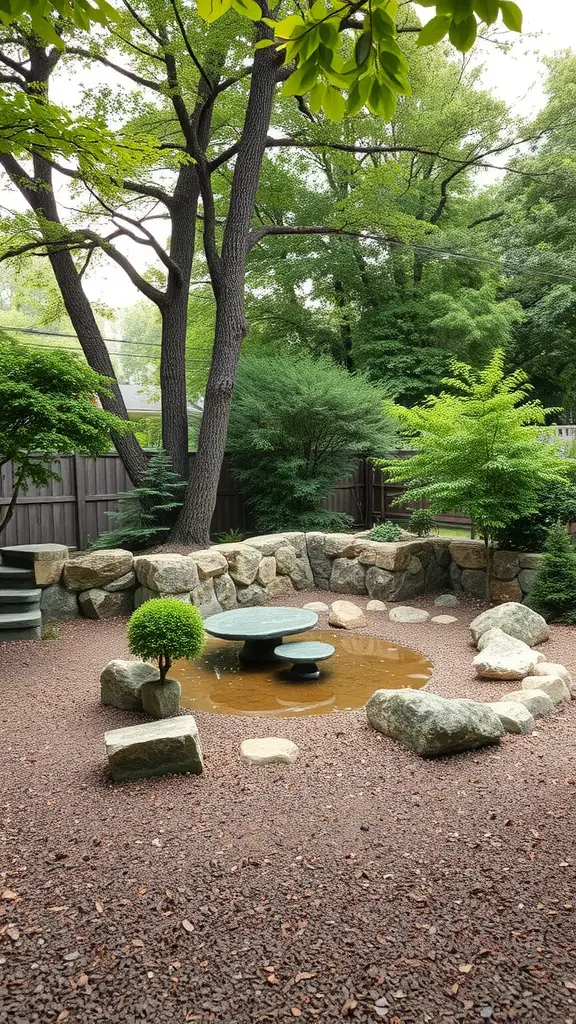
Choosing the right spot is crucial for your Zen garden. The picture showcases a peaceful outdoor area. It features vibrant plants and carefully placed rocks. This environment perfectly promotes relaxation and inner peace.
Find a secluded and tranquil area in your yard. Aim for a space that promotes relaxation, similar to the featured garden. Use mature trees and dense shrubs to create a natural screen, enhancing privacy. Observe the sun’s path across the area during the day. A mix of sun and shade will establish a soothing atmosphere.
The strategic placement of stones, water elements, and flora is key. Notice how the stones in the image invite discovery and reflection. As you plan your space, consider incorporating features that guide the eye throughout the garden, all while preserving a sense of equilibrium.
Consider accessibility for your 2025 Zen garden design. Ensure easy access for regular enjoyment. A thoughtfully designed path enhances the experience. Like the steps in the image, it guides you into your tranquil space.
Utilizing Gravel and Sand Patterns

Zen gardens use gravel and sand patterns to foster tranquility. This image showcases meticulously raked gravel waves, promoting serene reflection. Experience the calming effect of this artful arrangement.
Gentle, fluid curves evoke the soothing flow of water, bringing a vibrant energy to your garden. The interplay of contrasting hues, such as light beige and soft blue, elevates the visual experience while maintaining a peaceful atmosphere. These carefully selected colors represent calmness and clear thinking, adding deeper meaning to your outdoor space.
Crafting your Zen garden? Consider mirroring those serene patterns. Experiment with gravel textures and colors to build depth. This enhances visual appeal and echoes the calming essence of water and waves.
While raking designs, embrace the meditative quality of the activity. Every wave you form offers a moment to connect with the earth and quiet your thoughts. Pick up your rake and savor the experience of crafting your personal Zen garden.
Essential Elements of a Zen Garden
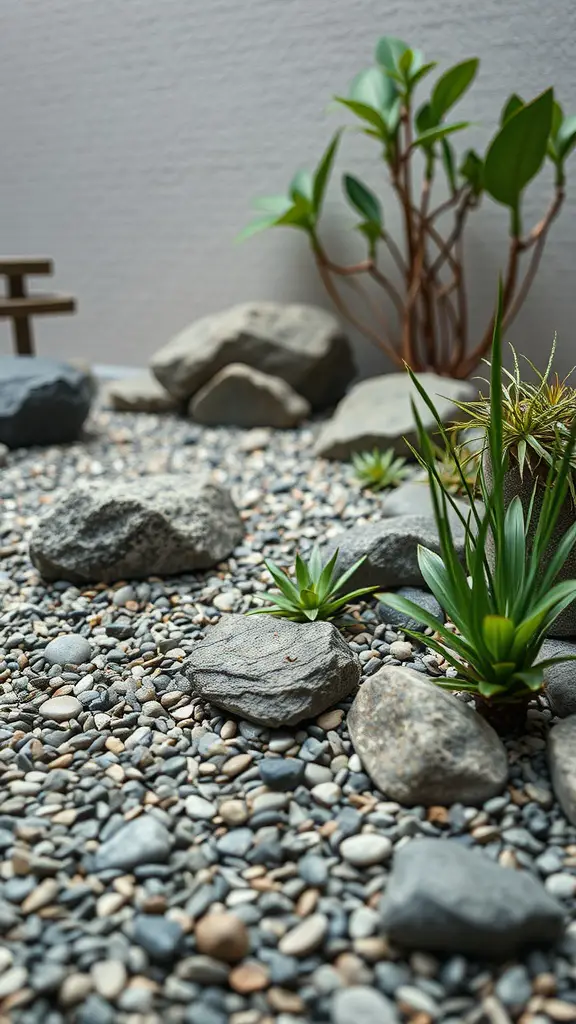
A Zen garden, often called a Japanese rock garden, offers a peaceful environment. It’s perfect for meditation and focused awareness. This image showcases the essential components of this tranquil garden style.
Stones are essential in Zen gardens. They symbolize mountains or islands, fostering stability and lasting peace. Here, stones of different sizes and forms are thoughtfully placed within smooth gravel. This arrangement draws the viewer’s gaze and promotes a serene environment.
Gravel or sand remains a key component. It’s carefully raked to form designs mirroring water ripples. This textured surface acts as both a foundation and a creative outlet for contemplation. The gravel’s soft hues amplify the garden’s serene atmosphere.
Even with its sparseness, plant life brings vitality. Notice the small plants, representing growth and fresh starts. Their green leaves create a beautiful contrast against the rocks, offering visual harmony.
Finally, a basic seating spot invites guests to relax and savor the peace. A bench or stone seat offers a place for quiet reflection, deep breaths, and a connection with the outdoors. This small feature turns a garden into your own private escape.
Incorporating Statues and Ornaments
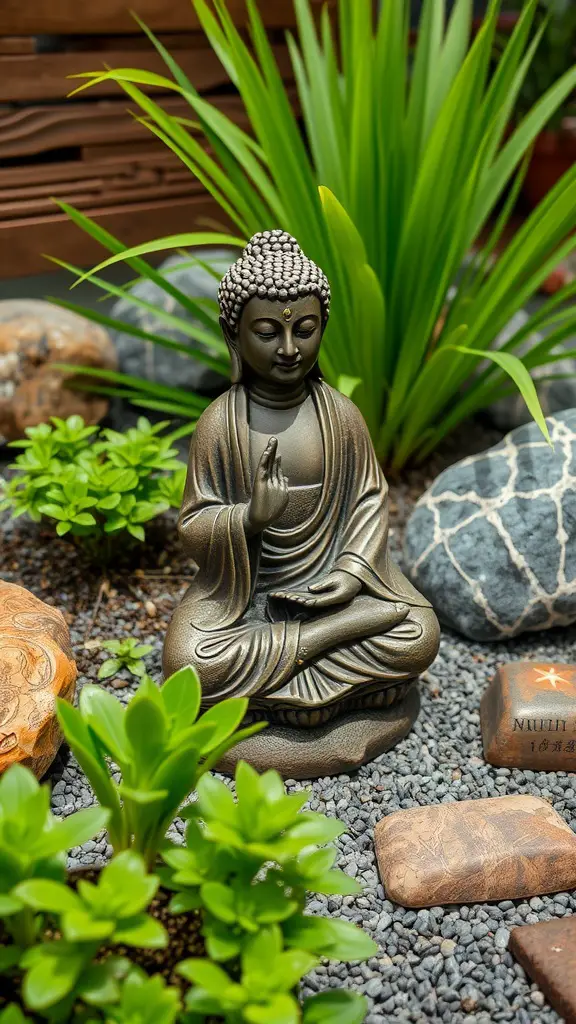
Enhance your zen garden design with carefully chosen statues and ornaments. A Buddha statue is a classic addition, promoting peace and mindfulness. This serene, seated figure inspires quiet contemplation and inner calm.
Lush greenery and polished stones beautifully frame the statue, achieving perfect harmony. Take a moment to appreciate nature’s beauty. This simple addition promotes relaxation in your garden.
When decorating, think carefully about where you put your ornaments. Placing them among plants or rocks can make them stand out beautifully without dominating the area. A small statue, such as the one pictured, can serve as a central attraction or a delicate detail, depending on your arrangement.
Lighting Considerations for Zen Gardens
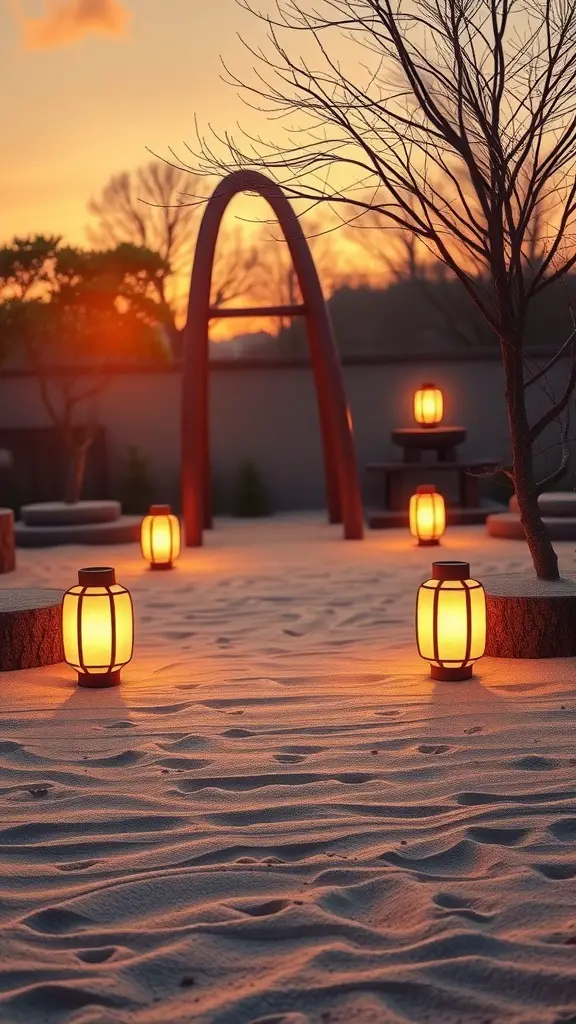
In 2025, lighting remains key to a zen garden’s design. It elevates the ambiance and fosters tranquility. Notice the elegant lanterns in the image, bathing the sand in a gentle light. This lighting offers both visibility and a comforting warmth to the garden.
Gentle, soft lighting perfectly complements zen gardens. It fosters a sense of calm and introspection. The subtle glow from lanterns highlights natural features. This invites you to pause and admire the surrounding tranquility.
Effective lighting placement is key. Position lanterns thoughtfully along paths or near garden highlights, such as the archway pictured. This guides visitors gently, creating a clear path without being too bright.
Select light fixtures that harmonize with your garden’s natural elements. The lanterns shown enhance the garden’s organic aesthetic. Employ warm-toned lighting to mimic the sunset’s glow, amplifying the space’s peaceful ambiance. Consider energy-efficient LED options for a modern, eco-friendly approach.
Consider the interplay of light and shadow. Shadows enhance the garden’s depth. Notice how the branches and lanterns create shadows in the image. This fosters a tranquil atmosphere, ideal for meditation and peaceful contemplation.
Edging Techniques for Zen Garden Boundaries
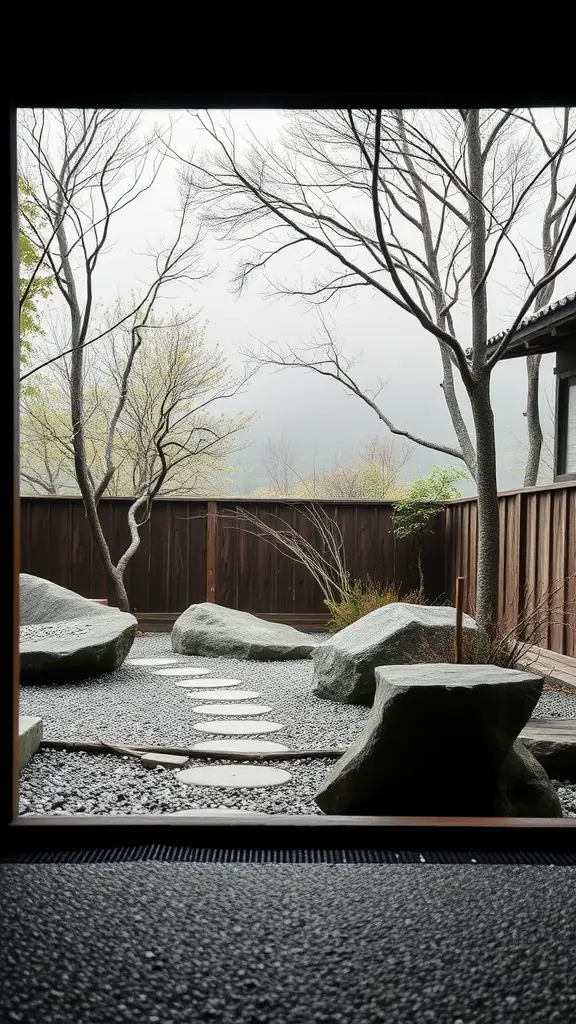
In a Zen garden, spatial definition is crucial. It’s as vital as the garden’s components. This image presents a stunning garden arrangement. Stepping stones guide you across smooth pebbles and natural stones. The design highlights simplicity and peace, core Zen garden characteristics.
Garden edging is key to a tranquil outdoor space. Natural materials, such as wood or stone, offer gentle borders that harmonize with the garden’s look. The stone edging in the picture, for example, directs attention and contains the gravel, improving the design.
Consider using plants as organic partitions. Compact shrubs or moss create soft borders and introduce varied textures. The trees in the picture provide height and elegantly define the area. Adding these features can blend your garden seamlessly with the surrounding environment.
Craft a serene sanctuary. Maintain crisp, organic borders. Integrate stones, wood, or foliage for a balanced, naturally refined aesthetic. Strive for curated simplicity.
Symmetry vs. Asymmetry in Zen Designs
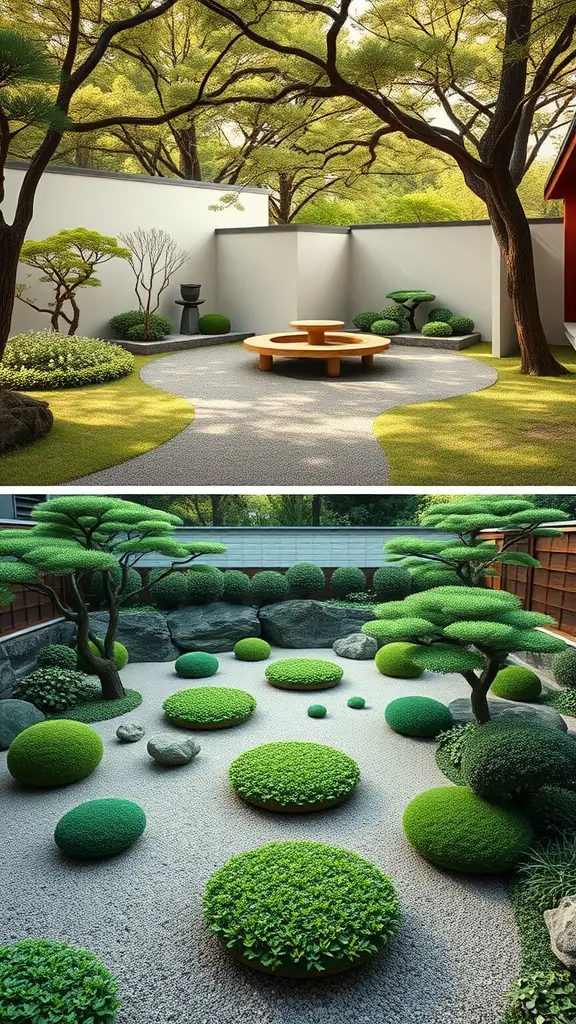
Zen gardens in 2025 frequently use symmetry and asymmetry for peaceful effects. The initial image displays a garden with well-balanced features. A circular seating space sits precisely at the center. It’s bordered by thoughtfully arranged plants and gentle curves. This arrangement promotes balance and serenity. It’s an ideal location for quiet reflection.
The second image showcases asymmetry with elegance. Notice the dynamic flow created by the round shrubs and stones. Their varied sizes and positions guide your gaze, generating movement while preserving tranquility. This natural balance of controlled disorder enriches the garden’s character.
Both symmetrical and asymmetrical designs enhance the Zen experience uniquely. Symmetrical gardens offer a sense of order. Asymmetrical gardens create a feeling of natural freedom. Choose the design that best reflects your personal preferences and desired atmosphere.
Creating Private Spaces within Zen Gardens

Zen gardens promote serenity. Designing private areas amplifies this peaceful atmosphere. The image showcases natural elements creating a secluded haven. Deliberately positioned stones and vibrant plants encourage reflection and quiet contemplation.
Creating these areas frequently means blending diverse textures and levels. Observe the rocks’ varying forms and dimensions. They offer visual appeal while preserving balance. The gentle foliage introduces a soothing element. This makes it ideal for reflection or nature appreciation.
Pathways are key. Notice the delicate stones in the image. They invite you to explore the garden. These paths lead to your own peaceful retreat. Escape the daily grind and find serenity here.
Adding water features or well-placed seating boosts privacy. Picture yourself relaxing on a bench, listening to nature’s soft sounds. It’s an easy way to refresh your mind and body.
In 2025, crafting secluded areas in a Zen garden remains about achieving harmony. Skillfully blending diverse components allows you to design a tranquil setting. It also provides a personalized sanctuary that resonates with your inner calm.
The Role of Pathways in Zen Gardens
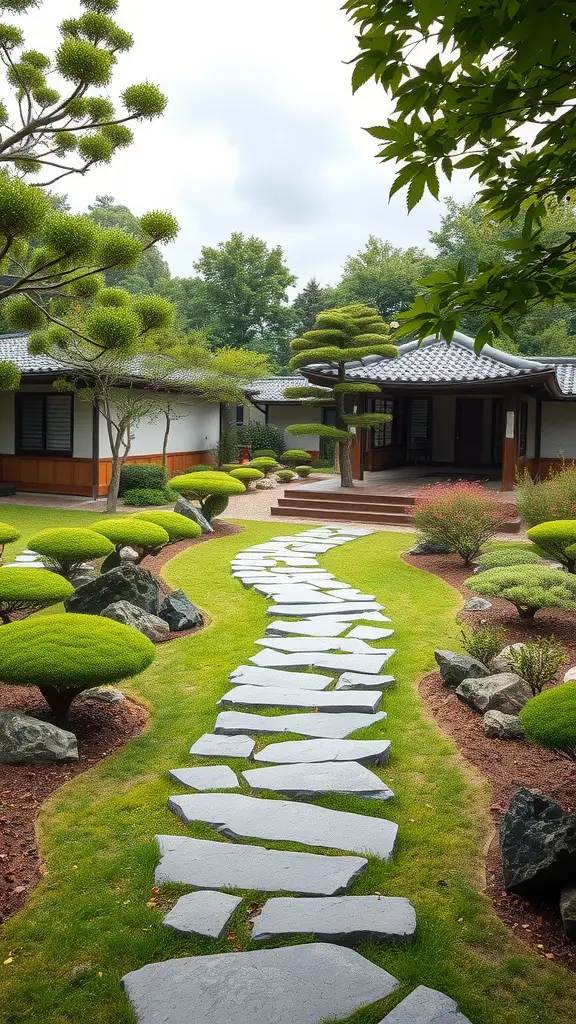
Zen garden pathways offer more than simple passage. They guide mindful meditation and quiet reflection. The image showcases a winding stone path, encouraging visitors to slow their pace and fully absorb the serene environment.
This garden embraces natural elements, such as the gray stones, blending seamlessly with the lush greenery. This integration of the pathway and the surrounding environment fosters a feeling of natural progression. Strolling along the path, you’ll observe meticulously pruned plants and textured rocks enhancing the visual appeal.
Walkways invite discovery. They guide you to secluded areas ideal for quiet contemplation. Here, the pathway’s soft bends spark intrigue, making you wonder what’s around the corner. This design element enhances the garden’s allure.
Furthermore, consistent upkeep of these paths is key to the garden’s peaceful atmosphere. Straight stones and neatly trimmed grass enhance its beauty. This also makes visitors feel comfortable and invited as they explore.
Incorporating Focal Points in Zen Design

Zen gardens thrive on focal points, fostering peace and equilibrium. This image presents a serene arrangement where nature blends seamlessly with design. A large, distinctive rock commands attention, serving as the primary visual element. This stone grounds the landscape, encouraging reflection.
Vibrant green foliage softens the rugged rocks. This garden’s design guides a peaceful journey. Carefully pruned shrubs create order and enhance serenity. Each element has a purpose.
Crafting your Zen garden? Think about how each element enhances its key features. Small rocks, calming water features, or a comfortable bench can act as secondary focal points. Prioritize balance and promote mindful reflection, fostering a deeper connection with the natural world.
Finding Inspiration from Nature
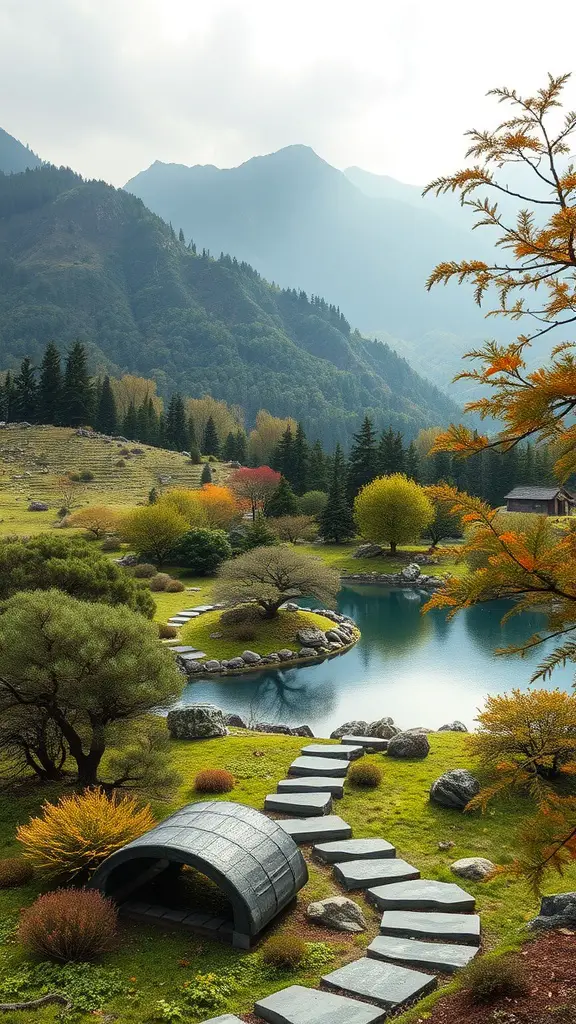
Nature inspires the best garden designs. A beautiful garden offers tranquility and peace. Picture a space with bright flowers and soothing water features, perfectly balanced for relaxation.
The photo showcases a serene pond mirroring lush greenery and majestic mountains. The water’s soft curves offer a stunning contrast to the stepping stone path. This design promotes mindful exploration and reflection, urging us to savor each moment and appreciate every nuance.
Vibrant foliage, now touched with autumn hues, demonstrates the beauty of seasonal shifts in a garden. Every season offers unique appeal, transforming the space’s atmosphere and appearance.
Integrating natural materials, such as stones and greenery, fosters a balanced setting. Observe how the gentle curves of the terrain merge with the path’s defined borders. This interaction can spark ideas for crafting areas that are welcoming and stable.
Seasonal Changes in Zen Garden Aesthetics
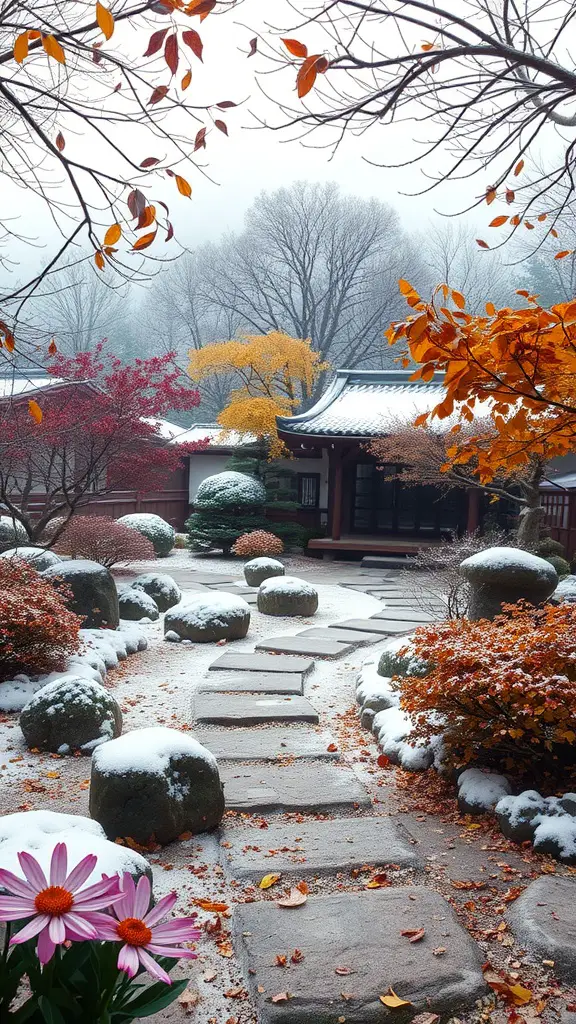
Zen gardens present a captivating beauty that evolves throughout the year. This image showcases a tranquil scene featuring snow, fall foliage, and a peaceful path. The enchanting view illustrates nature’s influence on a garden’s atmosphere.
Autumn brings a stunning display of orange and red. Leaves fall, blanketing the ground. This season encourages quiet contemplation and peace, perfect for meditation.
Winter’s snowy embrace turns the garden into a serene sanctuary. The pristine white snow creates a stunning contrast with any lingering vibrant greenery. This sharp contrast emphasizes nature’s enduring strength and provides a revitalizing viewpoint in 2025.
Zen gardens, such as this, invite us to notice subtle beauty. The carefully placed stones guide our path, promoting awareness with every footstep. Flowers emerging from the snow represent optimism and rebirth, highlighting life’s continuous flow.
In 2025, witnessing these seasonal shifts deepens our bond with the natural world. Every change offers fresh chances for tranquility and contemplation in our gardens.
The Importance of Maintenance in Zen Gardens
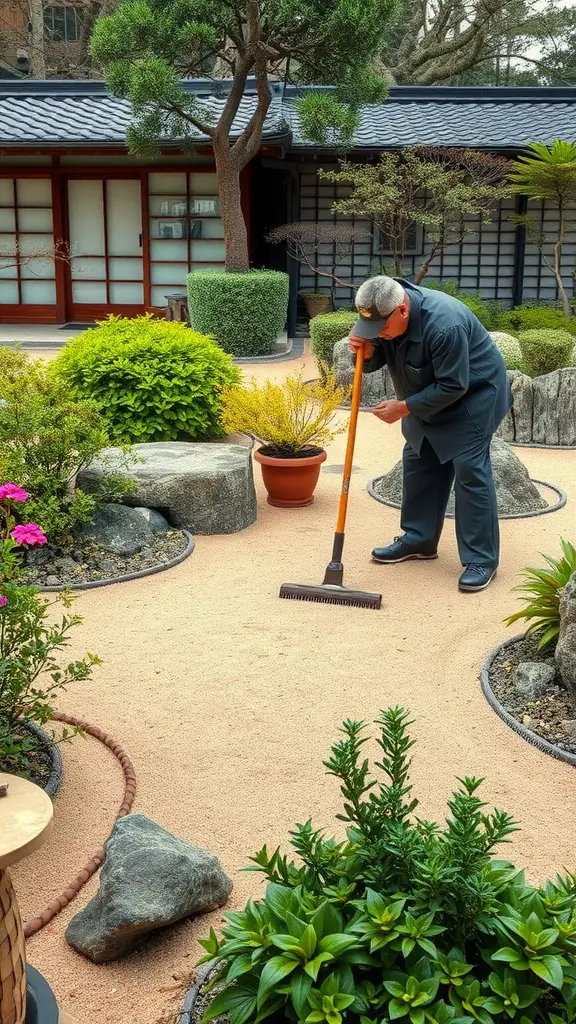
Zen gardens offer more than just beauty. They demand regular upkeep to maintain their tranquil allure. The photo shows someone dedicatedly performing this vital chore. Raking the sand sculpts the scenery and provides a calming, meditative practice.
Consistent upkeep is key to maintaining the harmony of a Zen garden. Similar to the individual pictured, dedicating time to garden care fosters a connection with nature, promoting inner peace. The goal is to design a serene environment that encourages relaxation and contemplation.
Keeping your Zen garden pristine involves easy upkeep. Rake the gravel, trim plants, and reposition stones as needed. These actions enhance the garden’s harmony. Regular care ensures positive energy flow. This transforms your garden into a peaceful retreat for relaxation.
Furthermore, garden upkeep offers therapeutic benefits. Focusing on each task promotes mindfulness, turning it into a fulfilling ritual. Whether you’re raking or pruning, remember that every action contributes to your Zen garden’s beauty and tranquility. Enjoy the process!
Color Schemes in Zen Gardens

In 2025, color remains vital in Zen garden design. It influences emotions and fosters tranquility. This image showcases a stunning blend of vivid floral hues and organic textures.
Vibrant pink blossoms capture attention and evoke a feeling of comfort. They beautifully contrast with the gentle gray stones and sand. Sunny yellow flowers inject a joyful element, enhancing the welcoming atmosphere.
A balanced color palette elevates the harmony of any Zen garden. Cool stone tones beautifully contrast with warm floral hues, fostering a serene ambiance. This equilibrium is vital for achieving tranquility, a cornerstone of Zen garden design principles.
Furthermore, using different blue tones, like those in the rocks, represents peace and profoundness. These colors combine to form a tranquil and harmonious space. It’s perfect for reflection and relaxation.
Integrating Art and Sculpture
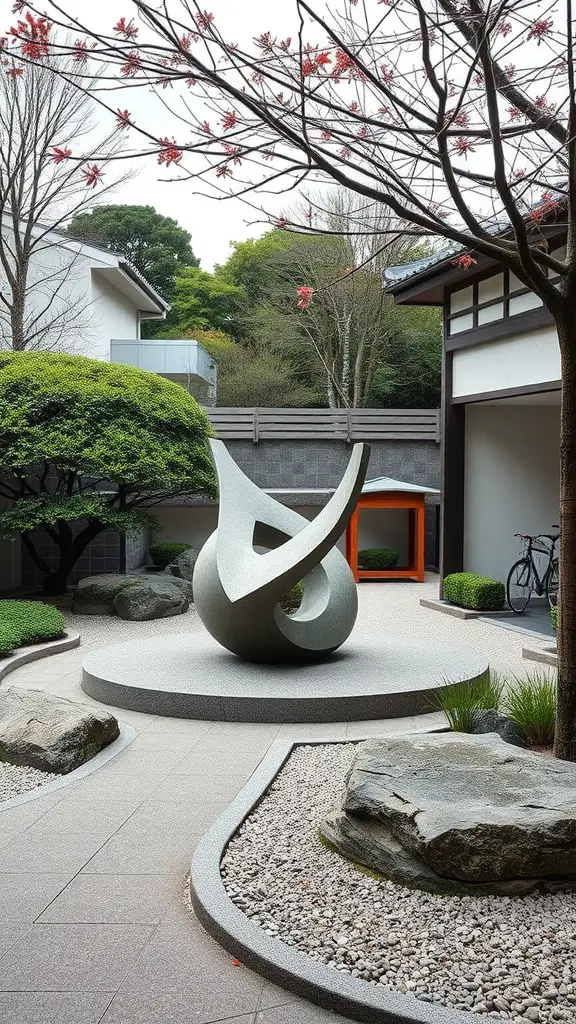
Zen gardens become tranquil havens when art and sculpture are thoughtfully incorporated. This image features a stunning sculpture, the garden’s central attraction. Its fluid lines and abstract form encourage reflection, harmonizing seamlessly with the natural landscape.
Selecting the right materials is key. This sculpture enhances the stone and gravel paths, achieving a pleasing equilibrium. The rocks’ delicate textures and the sculpture’s sharp lines combine to foster a sense of calm.
Integrating these artistic elements significantly boosts visual charm and fosters a sense of mindfulness. While wandering through the garden, sculptures capture your attention, inspiring moments of quiet contemplation.
Consider the environment around your sculpture. Thoughtful landscaping enhances its impact. Strategically placed plants and stones create a beautiful frame. Notice how a few carefully chosen shrubs and trees, such as the flowering one pictured, introduce color and vibrancy without dominating the scene.
In 2025, Zen garden art integration focuses on achieving serenity and equilibrium. Every component should enhance the others. This builds a harmonious space where nature and artistic expression blend seamlessly.
Sustainable Practices for Zen Garden Design
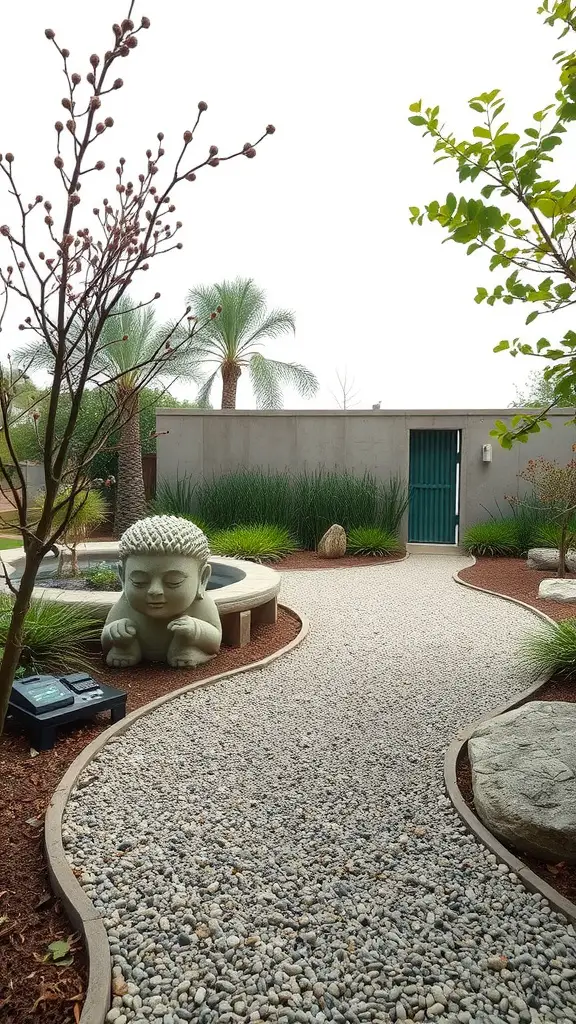
This image presents a stunning Zen garden, a true embodiment of natural balance. A meandering gravel walkway beckons exploration. The vibrant, verdant foliage enhances the garden’s peaceful ambiance.
Sustainable Zen gardens prioritize natural elements. The gravel path shown enhances beauty and aids rainwater absorption. This improves drainage, minimizes runoff, and supports the surrounding environment.
This stone statue serves as a central point, promoting calm and thoughtful contemplation. Opting for stone from local quarries reduces transportation-related carbon emissions. Furthermore, the plants bordering the path are probably drought-tolerant, an excellent decision for water conservation.
Using native plants boosts your garden’s appeal and helps local wildlife thrive. Attracting helpful insects and birds creates a balanced backyard ecosystem.
Finally, using mulch around your garden helps it retain moisture and prevents weeds. This simple solution keeps your garden beautiful and is environmentally friendly.
Mindfulness Practices in Zen Gardens

Zen gardens offer more than visual appeal. They provide havens for mindful contemplation and meditation. The image showcases a tranquil setting. A person sits peacefully, enveloped by artfully arranged stones and carefully selected flora. This environment encourages introspection and serenity, perfectly capturing the spirit of a Zen garden in 2025.
The person’s posture is centered and calm, showcasing mindfulness. They sit on the ground, connecting with the earth. Lush greenery surrounds them, fostering tranquility. These gardens offer spaces to pause and appreciate nature’s simple beauty. They are designed for reflection and peace.
Elevate your Zen garden experience in 2025 with mindfulness. Center yourself by focusing on your breathing. Notice the intricate designs in the raked gravel. These easy techniques calm your thoughts. Connect with nature for a profound sense of being present. Cultivate a tranquil and serene mental state.
Zen gardens, in essence, highlight the elegance of simplicity. Explore a physical garden or design your own personal sanctuary. The core principle remains: connect with your environment and discover peaceful moments.
Transforming Small Spaces into Zen Retreats
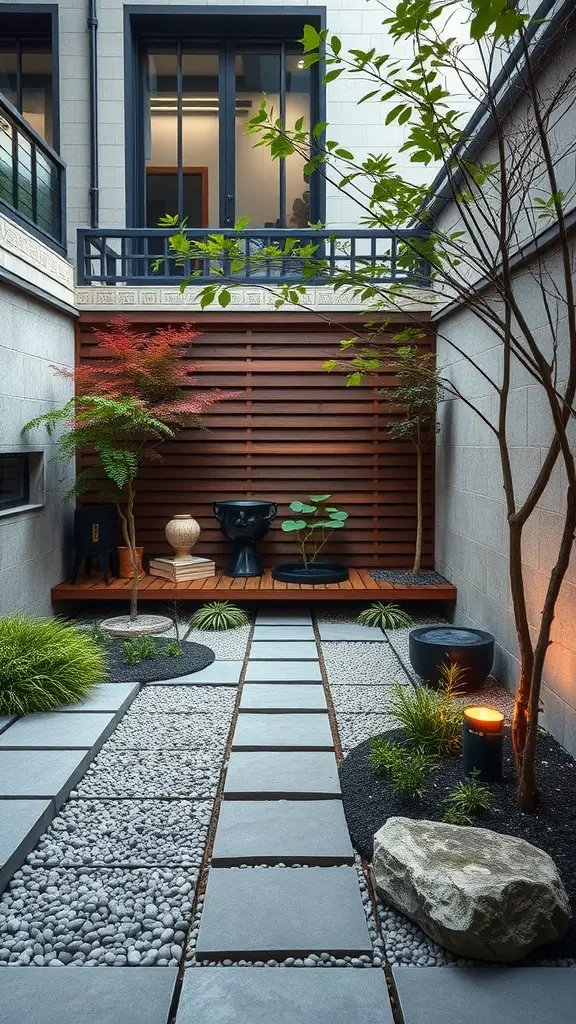
Even with limited space, a peaceful zen garden is achievable. This photo perfectly shows how a small area becomes a tranquil escape. Natural elements, such as stone and wood, enhance the garden’s warmth and serenity. This design remains a popular choice in 2025 for urban dwellers.
A stone path, crafted from sizable gray rocks, leads you through the garden. It encourages a leisurely pace, allowing you to fully appreciate the scenery. Small pebbles and darker stones fill the gaps, forming a beautiful contrast that amplifies the tranquil atmosphere.
Tucked away, a wooden deck provides a tranquil haven for relaxation or mindful meditation. Minimalist furniture enhances the natural surroundings, creating an ideal space to de-stress. Lush plants, featuring a petite tree and colorful greenery, inject vibrancy and energy. A carefully positioned stone anchors the space, promoting a sense of stability.
Effective lighting is also key. The soft candlelight produces a cozy ambiance, ideal for unwinding in the evening. This arrangement demonstrates how smart design transforms even a tiny area into a tranquil personal sanctuary.

